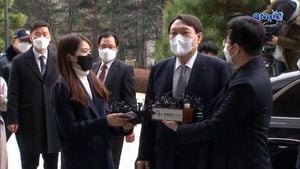On October 18, 2025, the streets of America filled with the energy of millions rallying under a single banner: "No Kings." From New York’s Times Square to Salt Lake City’s downtown, an estimated 7 million people gathered to protest what they viewed as a worrying drift toward authoritarianism in the United States. The movement’s message was clear—no single person should hold unchecked power in a democracy. Yet, as the demonstrations unfolded, an unexpected twist on social media quickly stole the spotlight and ignited a fresh wave of controversy.
That evening, President Donald Trump posted an AI-generated video on his Truth Social platform. The clip, lasting just 19 seconds, featured a digital likeness of Trump, complete with a golden crown, piloting a fighter jet emblazoned with the words “King Trump.” As the jet soared over a crowd of protesters—among them left-wing influencer Harry Sisson—the aircraft released a torrent of brown sludge, depicted as liquified excrement, onto the demonstrators below. The video, set to the unmistakable soundtrack of Kenny Loggins’ “Danger Zone” from the film Top Gun, quickly went viral, sparking outrage, debate, and a flurry of questions about the boundaries of political satire and presidential conduct.
According to Snopes, the video was not the original work of Trump himself. It had first appeared about six hours earlier on X (formerly Twitter), shared by the user @xerias_x, who described their account as specializing in "AI + Video Edits" and "Satire." In their post, @xerias_x captioned the video, “President Trump makes a quick appearance at the No Kings Protest.” The watermark bearing the username was visible in the clip Trump reposted. Despite the clear satirical intent claimed by its creator, the content’s crude imagery and its amplification by the president of the United States struck a nerve across the political spectrum.
For many, the video’s symbolism was hard to ignore. The brown substance—variously described in media reports as “brown sludge,” “apparent human excrement,” “poop-like substance,” or simply something that “appears to be feces”—was interpreted as a direct insult to the protesters and, by extension, to the fundamental right to dissent. The inclusion of Harry Sisson, a prominent Democratic social media influencer, as a target in the video only intensified the controversy. On October 19, Sisson took to X to demand accountability, posting, “Can a reporter please ask Trump why he posted an AI video of himself dropping poop on me from a fighter jet?”
The question didn’t go unanswered for long. Vice President JD Vance, ever active on social media, replied to Sisson’s post, promising, “I’ll ask him for you Harry.” Sisson, not missing a beat, responded, “Just add me to the Signal chat I’ll ask him myself.” The exchange, lighthearted on the surface, underscored the surreal nature of the moment—one in which the nation’s highest officeholder was publicly engaging with, and even mocking, his critics through AI-generated satire.
As the video continued to circulate, journalists sought reactions from political leaders. House Speaker Mike Johnson, pressed by reporters on October 20, stood firmly by Trump’s side. According to Politico, Johnson said, “The president uses social media to make the point. You can argue he’s probably the most effective person who’s ever used social media for that. He is using satire to make a point. He is not calling for the murder of his political opponents.” Johnson’s comments attempted to downplay the video’s significance, framing it as part of Trump’s broader strategy of leveraging social media for political messaging. However, he stopped short of clarifying what precise “point” Trump was attempting to make with the video.
Meanwhile, Utah’s six Republican members of Congress—representing a state where an estimated 15,000 people joined the “No Kings” protests—remained conspicuously silent. As reported by Utah Political Watch, none of the delegation responded to inquiries about whether they found the video appropriate or had any comment at all. As of Monday afternoon, not a single member had acknowledged or addressed the controversy on their official or social media channels. Their silence highlighted a broader reluctance among some GOP lawmakers to wade into the increasingly fraught intersection of politics, technology, and presidential rhetoric.
The video also raised legal and ethical questions beyond the political. Its soundtrack, the iconic “Danger Zone” performed by Kenny Loggins, was used without authorization. On October 20, Loggins released a statement on his website, making his stance unequivocal: “This is an unauthorized use of my performance of ‘Danger Zone.’ Nobody asked me for my permission, which I would have denied, and I request that my recording on this video is removed immediately.” The demand from Loggins added yet another layer to the controversy, spotlighting the murky terrain of copyright law in the age of AI-generated content.
For millions who marched in the “No Kings” protests, the video’s impact was both immediate and unsettling. Many saw it as emblematic of a political climate in which satire and mockery have eclipsed substantive debate. For Trump’s supporters, however, the video was just the latest example of the former president’s willingness to lampoon his critics and wield digital media as a weapon in the ongoing culture wars. As Speaker Johnson put it, Trump’s social media prowess is unmatched—though, as this episode shows, it often comes with consequences that reverberate far beyond the online world.
Yet, the controversy also raises larger questions about the role of AI in shaping political discourse. The ease with which such provocative content can be created and disseminated blurs the line between satire and slander, between free expression and targeted harassment. As the 2026 election cycle looms, the incident serves as a warning sign: the tools of digital manipulation are only getting more sophisticated, and the stakes for democracy have never felt higher.
In the end, the “No Kings” protests were meant to send a message about the dangers of unchecked power. Ironically, it was a brief, AI-generated video—shared by the very person at the center of the protests—that ended up dominating the national conversation, reminding everyone just how unpredictable the battle for the American narrative has become.




